
Top 25 Rankings 1901-1935
1930 National Championship
Home
1930
College Football Top 25
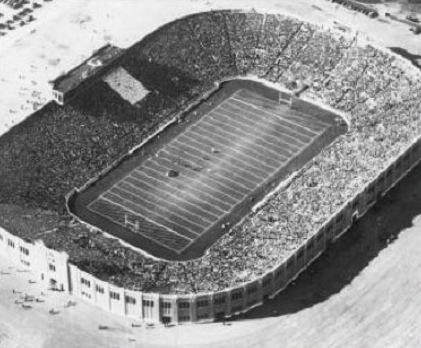
Here is Notre Dame Stadium on October 11th, 1930, when it was
officially dedicated for the Navy game. The stadium's first actual game
featured Southern Methodist the previous week. Notre Dame, the defending
mythical national champion (MNC), won all its games again in 1930,
finishing 10-0. It was the climax of Notre Dame's first era of
greatness, but also its last chapter. Their legendary coach, Knute
Rockne, died in a plane crash the following Spring, bringing an end to
college football's "Golden Age."
Alabama also went 10-0, and they share the MNC for 1930 with Notre
Dame, but there is no doubt that Notre Dame would have been rated #1 in
an AP poll had there been one in 1930, even a post-bowl poll that
followed Alabama's 24-0 rout of 9-1 Washington State in the Rose Bowl.
A detailed summary and comparison of the 2 teams can be found in my 1930 national championship article. Either team could viably be ranked #1, but since an AP poll would have gone with Notre Dame, that's how we'll start here: Notre Dame #1, Alabama #2.
The full hypothetical post-bowl AP poll top 25 for 1930, fixed to make
logical sense of course, follows the article below. This was an
exceptionally tough top 25 to put together, taking me several weeks of
differing iterations before it felt right. The biggest sticking points
were 8-2 Vanderbilt and 7-3 Oregon State, both of whom I would rate
much higher than a 1930 AP poll would have. Ultimately, I went with the
hypothetical wishes of hypothetical AP poll voters on these teams, but
either team could viably ranked in the top 10.
#3: Northwestern
As
I noted in my 1930 national championship article, 7-1 Northwestern
would have very likely finished ranked #3, even though they lost their
last game and fellow Big 10 champion Michigan had a better straight
record at 8-0-1. Regardless of where an AP poll would have ranked
Northwestern, however, they definitely should be ranked #3.
Northwestern's loss came to #1 Notre Dame, and they won every other
game by more than a touchdown, beating 8-1 Tulane 14-0, 5-2-1 Ohio
State 19-2, and 6-2-1 Wisconsin 20-7.
Michigan did not defeat as
many top 25 caliber teams, they had 4 close wins, 3 of them over
unrated opponents, and they were tied by 5-1-2 Michigan State, who was
good but will not quite make this top 25. Michigan would have been
overrated due to their name value and straight record, but they belong
in the bottom half of the top 10 (at best).
Northwestern #3.
#4: Southern Cal vs. Washington State
9-1 Washington
State won the PCC, edging 8-2 Southern Cal 7-6 at home, and their only
loss came 24-0 to #2 Alabama (10-0) in the Rose Bowl. However, that
loss would have almost certainly knocked WSU back behind USC in a
post-bowl AP poll. Fair?
Fair. WSU's win over USC came at home, and was as slight as could
be, and USC outperformed them quite a bit on the season while playing a
tougher schedule. WSU beat 4-5 California 16-0 and USC beat them 74-0,
WSU beat 7-3 Oregon State 14-7 and USC beat them 27-7, and WSU beat 5-4
Washington 3-0 and USC beat them 32-0. Furthermore, USC defeated 9-1-1
Stanford 41-12, and WSU did not play Stanford. USC's 2nd loss came 27-0 to #1 Notre Dame, very similar to WSU's loss to Alabama.
As you can see, USC's performance was rather impressive this season
outside of their loss to Notre Dame, and the Trojans, of course, would
go on to win a pair of MNCs over the next 2 seasons.
USC and WSU lost only to top 5 teams, whereas Michigan was tied by an
unrated team, so USC and WSU should both be rated higher than Michigan.
Southern Cal #4, Washington State #5.
#6: Tulane vs. Tennessee
8-1 Tulane and
9-1 Tennessee might have been ranked as low as #11-15 in a 1930 AP
poll, but Tulane's only loss
came at #3 Northwestern, Tennessee's at #2 Alabama, and both belong in
the top 10. The South was not well respected as a football
region at this time, and as I've demonstrated in other articles, the
South fared poorly in intersectional games in the 1920s. However, that
was not the case in 1930, and the South would prove to be much stronger
throughout the 1930s than it had been the previous decade.
In games between major teams, the South was 9-5-2 this season against the
East, Great Lakes, Southwest, and West Coast regions, and they were 5-1
in their most high-profile intersectional games:
- 10-0 Alabama won 24-0 over 9-1 Washington State in the Rose Bowl
- 8-1 Tulane lost 14-0 at 7-1 Northwestern
- 8-2 Vanderbilt won 33-7 at 3-4-1 Minnesota
- 7-2-1 Georgia won 18-14 at 5-2-2 Yale
- 7-2-1 Georgia won 7-6 at 7-3 NYU
- 8-1-2 Duke won 18-0 at 6-5 Navy
Notice that all of those games were on the road. Just one season before, the South had only gone 3-15 against the East,
Great Lakes, Southwest, and West Coast regions, so obviously 1930 was a massive turnaround and a breakthrough
season for the South.
Tulane
and Tennessee took no upset losses, and like Southern Cal and
Washington State, they should be ranked ahead of 8-0-1 Michigan, who
tied an unrated team. Other teams that might have been rated higher
than Tulane and Tennessee also suffered upsets-- 9-1-1 Stanford tied an
unrated team, 8-1 St. Mary's lost to an unrated team (and 8-1 Fordham
lost to St. Mary's), and 9-1-1 Army and 7-1-1 Dartmouth both tied 5-2-2
Yale (will be ranked #21).
Tulane
and Tennessee were rather similar, and it's hard to say which one an AP
poll would have preferred, but Tulane posted 1 close win
and Tennessee posted 2, and on that slim difference we'll rank Tulane
higher. Tulane also shared the Southern Conference title with Alabama,
which would have given them an edge over Tennessee in a poll. Tulane's
big win came 25-0 over 7-2-1 Georgia, who will rank
#17, and Tennessee's big win came
13-0 at 8-2 Vanderbilt, who will be
ranked #18.
Tulane #6 and Tennessee #7.
#8: Michigan vs. Stanford
8-0-1 Michigan
and
9-1-1 Stanford were another pair of similar teams. Stanford lost 41-12
to #4 Southern Cal at
home, which
is a poor performance to be sure, but Michigan did not play a team
nearly as strong. Both teams took an upset tie to an unranked opponent,
Michigan against 5-1-2 Michigan State and Stanford with 3-4-1
Minnesota,
and both defeated a pair of top 25 teams, Michigan beating 5-2-1 Ohio
State and 6-2 Purdue, Stanford beating 7-1-1 Dartmouth and 7-3 Oregon
State. A 1930 AP poll would have
rated Michigan higher, and Michigan did defeat the team that tied
Stanford, 3-4-1 Minnesota, so we'll let the hypothetical AP poll rating
stand.
Michigan #8, Stanford #9.
St. Mary's (California) and Fordham
8-1
St. Mary's and 8-1 Fordham, who lost 20-12 to St. Mary's at home,
likely would have been rated next in line by an AP poll, and that'll
work, if just barely. St. Mary's took their loss 7-6 at 4-5 California,
and I'd rate them (and Fordham) lower because of that, but St. Mary's
performed well otherwise, and they finished strongly, winning their last
6 games, capped by the victory at Fordham and a 7-6 win over 7-2
Oregon. Fordham defeated 8-2 Holy Cross, 7-3 NYU, 5-3-2 Detroit, and
6-3 Bucknell.
St. Mary's and Fordham had both gone unbeaten in
1929, so each had the attention of the football world this season,
especially when they played each other late in the season. It was their
first game against each other, but they would play 11 more times
1932-1942. Fordham won the series 7-4-1.
St. Mary's #10, Fordham #11.Army and Dartmouth vs. Colgate
Next in line we
have 9-1 Colgate, 9-1-1 Army, and 8-1-1 Dartmouth. Colgate took an
upset loss at 5-1-2 Michigan State (unrated, but close to the top 25),
while Army and Dartmouth each took an upset tie at 5-2-2 Yale (will be
#21), so Army and Dartmouth were both effectively a half game better
than Colgate on the season. Army's loss came 7-6 to #1 Notre Dame in
New York City, and Dartmouth's came 14-7 at #9 Stanford in their finale, so both losses are irrelevant when comparing Army and Dartmouth to Colgate.
Colgate's loss to an unrated team leaves them with a relevant record that is worse than several more teams to come in this top 25, so they'll be dropping quite a bit from here.
As
for Army and Dartmouth, the teams had twin seasons-- a close loss to a
top 10 team, a tie at Yale, a close win at Harvard, and no wins over
top 25 teams. Army got a lot of praise for their 1-point loss to Notre
Dame (#3 Northwestern lost 14-0 to Notre Dame the week before, and #4
Southern Cal lost 27-0 to them the week after), and as such likely
would have been rated higher than Dartmouth by an AP poll.
Army #12, Dartmouth #13.
Ohio State, Wisconsin, and Purdue
5-2-1 Ohio State
lost to #3 Northwestern and #8 Michigan, and they tied 6-2-1 Wisconsin.
Wisconsin's losses came to #3 Northwestern and to 6-2 Purdue. Purdue had
been a top 10 team in 1929, and they appeared to be top 10 again for
most of this season, starting 6-1 with the loss coming by 1 point at #8
Michigan, but then they lost their finale 7-6 to 2-5-1 Indiana at home.
Ohio State should be ranked higher than Purdue because they took an
upset tie and Purdue took an upset loss, never mind that the team that
tied Ohio State (6-2-1 Wisconsin) was vastly better than the team that
beat Purdue (2-5-1 Indiana). Ohio State also defeated 6-2-1 Pittsburgh
(will be #24).
With Ohio State ranked ahead of Purdue, Wisconsin should be ranked
higher than Purdue as well. Purdue's head-to-head win over Wisconsin
was by a mere 7-6 at home, so not decisive. Purdue's upset loss to
Indiana balances out the head-to-head win, and Wisconsin's tie with a
higher-rated team (Ohio State) gives the Badgers a relevant record that is effectively half a game better than Purdue's for the season.
Ohio State #16, Wisconsin #17, and Purdue #18.
Ohio State
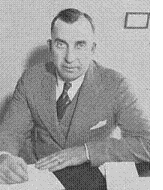
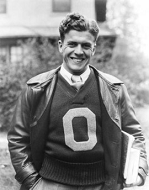
Ohio
State was coached by alumnus Sam Willaman (pictured above at left). He
had gone 14-15-3 at Iowa State 1922-1925, and he went 26-10-4 at his
alma mater 1929-1933. Ohio State was a top 25 team every year he was
there, and he went 7-1 in 1933, yet somehow all this was simply not
good enough, and he was pressured to resign after that season. This has
been a longstanding tradition at Ohio State. Willaman moved on to
Western Reserve, where he went 7-1-1 in 1934, but that was it for him,
as he died during surgery for an intestinal ailment just before the
1935 season was to begin. He was 47-26-9 overall.
Ohio State's
star player this season was Hall of Fame end Wes Fesler (pictured above
at right in his student attire), a consensus All American for the third
straight year. This year he was a unanimous choice, and he was also
named MVP of the Big 10. He was Ohio State's best receiver, but he was
very versatile and was sometimes moved into the backfield to run, pass,
or block. Grantland Rice listed Fesler on his 1939 all-time team.
Georgia and Vanderbilt
Although
7-2-1
Georgia had a slightly worse straight record than did 8-2 Vanderbilt, I
think an AP poll would have ranked Georgia higher, so that's what we're
going with here. Georgia was tied by unrated 6-3-1 Florida, and
Vanderbilt took no upsets, but Georgia played a far tougher schedule,
and they got a lot of attention this season
for a pair of high-profile wins up north, 18-14 at 5-2-2 Yale
(#21) and 7-6 at 7-3 NYU (#23). Their losses came to #2 Alabama and #6
Tulane, while Vanderbilt's came to #2 Alabama and #7 Tennessee.
I would rate Vanderbilt much higher than this myself-- probably #8,
behind Tennessee. They took no upsets, while #8 Michigan (8-0-1) and #9
Stanford (9-1-1) were each tied by an unrated opponent. Moreover,
Vanderbilt won 33-7 at Minnesota, while Stanford was tied at Minnesota
the next week, and Michigan only beat Minnesota 7-0. On the other hand,
Michigan and Stanford each defeated a pair of top 25 teams, and
Vanderbilt did not. On that basis, I'm bowing to the pretend wishes of
hypothetical 1930 AP poll voters here. But Vanderbilt could be viably
rated as high as #8.
Georgia #17 and Vanderbilt #18.
Colgate, Utah, and Yale
Colgate
had a worse relevant record than did Ohio State, Wisconsin, Purdue,
Georgia, and Vanderbilt, which is why I'm ranking them behind all those
teams. They had a worse relevant record than did 8-0 Utah as well, but
Utah did not defeat a team outside the Rocky Mountain region, and as
such their schedule did not compare well to Colgate's.
Utah had
gone 5-0-2 in 1928 and 7-0 in 1929, and there was national awareness of
them this season because of that, but they did not play a team out of
their region in any of these 3 years, so esteem for them was somewhat
limited. Still, they performed impressively this season, outscoring their opponents
340-20 (average score 43-3), no one coming within a touchdown of them. Their best
win was 34-0 at 6-1-1 Colorado.
One could argue that for all we
know, Utah was a top 10 team this season power-wise, but it seems very
unlikely. In 1931, they attempted to prove themselves with a pair of
games against major West Coast teams, losing those games 7-6 to 5-3-1
Washington State and 12-0 to 6-3-1 Oregon State to finish 7-2. Yet they
stomped on their own region as impressively as they did in 1930
(average score 41-2). In 1932, Utah took their only loss 35-0 to
Southern Cal. I doubt very much that Utah was actually a top 25 team
this season, but an AP poll would likely have rated them about here
(#20), and they did rout everyone they played, so #20 is a viable
rating.
5-2-2 Yale tied #12 Army and #13 Dartmouth, and they
lost a close game to #17 Georgia, but they were upset 13-0 by 4-4-1
Harvard in their finale, which pretty much ruined an otherwise decent
season for them. Still, the loss was balanced out by their ties with
higher-rated teams. 6-2-1 Pittsburgh would likely have been rated
higher, but Pitt was tied by an unrated opponent and accomplished
nothing against higher-rated opponents to make up for it, so Yale had
the better relevant record.
Colgate #19, Utah #20, and Yale #21.
Utah
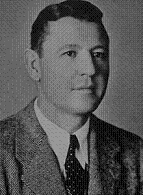
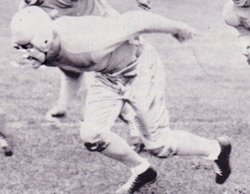
Utah
ruled the Rocky Mountain region for 25 years under Hall of Fame coach
Ike Armstrong (pictured above at left). He was a Drake graduate who
went 141-55-15 at Utah 1925-1949, winning 13 conference titles. He then
became the athletic director at Minnesota 1950-1963. Armstrong has the
most wins and the longest tenure in Utah football history.
Utah's
star player this season was Hall of Fame fullback Frank Christensen
(pictured above at right). He was a 3rd team All American this season
and next, and made first team AA on one list in 1932. He scored 100
points this season, and he is still Utah's all-time leading scorer with
235 career points. After college he played for the Detroit Lions,
winning a championship in 1935.
Utah simply crushed other Rocky
Mountain teams during this time. They went 7-0 in 1929, 8-0 this
season, and 7-2 the next (losing to 2 West Coast teams), and no team
from their region came within a touchdown of them in any of those
seasons. Pictured below is Utah carrying the ball in this season's
finale against Utah State, a typical 41-0 win for the Utes. However,
Utah did not fare so well against power teams outside their region, and
their unbeaten 1929 and 1930 squads are the only 2 of Armstrong's 25
teams that would have made a top 25. And had those 2 squads played
major opponents from the West Coast, I suspect that they would have
proven less than worthy of top 25 slots as well.
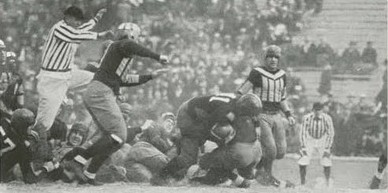
Oregon State, New York, and Pittsburgh
7-3
Oregon State and 7-3 New York did not take any upsets, so both should
be rated higher than 6-2-1 Pittsburgh, who was tied at unrated 4-3-2
Nebraska. NYU also beat 6-3 Carnegie 20-7 on the road, while Pitt beat
Carnegie just 7-6 at home. I don't know whether a 1930 AP poll would have
preferred Oregon State or NYU, but OSU's wins were all by more than a
touchdown, while NYU edged 5-5 Georgetown 2-0 at home, and OSU had the
stronger finish, so we'll rate OSU higher here.
As
with
Vanderbilt, I would rate Oregon State much higher than this myself,
probably between #9 Stanford and #10 St. Mary's. St. Mary's took an
upset loss to 4-5 Cal, while OSU took no upsets, and OSU beat 7-2
Oregon 15-0 one week before St. Mary's edged Oregon 7-6. Oregon State's
performance this season was also pretty much perfect for a 7-3 team.
They did lose 27-7 at #4 Southern Cal, but USC did that to most of the
teams they played this season-- the Trojans beat #9 Stanford 41-12 on
the road. Oregon State lost to #5 Washington State by 7 points and to
#9 Stanford by 6, indicating that they weren't far behind those teams.
However, as with Vanderbilt, Oregon State did not actually
defeat any teams that make this top 25, and that is the rationale
behind letting the hypothetical AP poll voters of 1930 have their way
here.
Yale, who sits right in front of OSU, was upset by unrated
Harvard in their finale, but that is a major rivalry game, and Yale
balanced that upset loss out with 2 ties to higher-rated teams. Those 2
ties were more than OSU accomplished in any of their wins. So while OSU
could viably be rated as high as #10, #22 will work as well.
Oregon State #22, New York #23, and Pittsburgh #24.
New York

New York
University enjoyed a brief window of national football prominence under
head coach Chick Meehan (featured in the Camel advertisement above). He
had been a quarterback for Syracuse 1915-1917, then head coach of his
alma mater 1920-1924, going 25-8-4. He fielded a top 25 caliber team in
each of those 5 seasons.
NYU, desiring a big-time football
program, hired Meehan away, and 1925-1931 he went 49-15-4 there, giving
him the most wins and the best winning percentage of any coach in NYU's
football history. They played a national schedule, including games
against Nebraska, Missouri, Georgia, Oregon, Oregon State, and
Tennessee, in addition to top teams from the East. Three of Meehan's
NYU teams were top 25 caliber: 1926 (8-1), 1928 (8-2), and this 7-3 season. These were the only top 25 teams NYU ever fielded in football.
Meehan
moved on to Manhattan after the 1931 season, and with his departure NYU
was done as a football power. Meehan went 31-21-6 at Manhattan
1932-1937, finishing him at 115-44-14 overall. Excellent numbers given
where he was coaching. He was elected president of the National
Football Coaches Association in 1930, and Knute Rockne once called
Meehan "the best coach in America," yet he is surprisingly not in the
Hall of Fame.
#25: Carnegie, Minnesota, Michigan State, or Oregon?
So
who gets slot #25? A 1930 AP poll would have gone with 7-2 Oregon-- in
fact, a poll might have rated Oregon higher than 7-3 Oregon State, even
though OSU defeated OU 15-0. Oregon's other loss came 7-6 at #10 St.
Mary's.
3-4-1 Minnesota may have had a losing record, but they had the best relevant
record of the contenders, since all 4 of their losses came to ranked
teams (Vanderbilt, Northwestern, Michigan, and Wisconsin), and they
tied #9 Stanford. However, that tie was all Minnesota accomplished this
season, making it easy to dismiss it as an anomaly. They performed
rather poorly in general, losing 33-7 to Vanderbilt and only beating
2-5-1 Indiana 6-0. I think that rating Minnesota in the top 25 would be
logically viable, but not doing so is viable as well, and an AP poll
surely would not have done so.
Michigan State, who was a
mid-major at this time, had a fantastic start to the season, tying
8-0-1 Michigan (#8) and defeating 9-1 Colgate (#19) to open 4-0-1. But
then they fell apart down the stretch, losing 14-13 at 5-5 Georgetown,
beating North Dakota State 19-11, and tying 5-3-2 Detroit 0-0. That
leaves Michigan State with the same relevant record that Oregon had,
but of course MSU's finish was terrible, giving reason for Oregon to be
rated higher.
6-3 Carnegie also had the same relevant record
that Oregon had, but they had a stronger finish than Oregon did, and
they performed much better than Oregon did on the season as a whole.
Carnegie's 6 wins all came by more than a touchdown, including 32-13 at
7-3 Temple and 26-0 over 6-2-1 Washington & Jefferson to end the
season. Oregon, on the other hand, edged Linfield 6-0, Drake 14-7, 5-4
Washington 7-0, and 3-5 UCLA 7-0. Carnegie's losses came 21-6 at #1
Notre Dame, 20-7 to #23 NYU, and 7-6 at #24 Pittsburgh.
Carnegie gets slot #25 over Oregon due to a markedly better performance on the season.
Carnegie
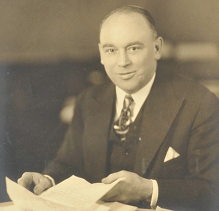
Although
I refer to this football program as simply "Carnegie" in these articles
for the sake of simplicity (or laziness?), the school was known as
Carnegie Tech at the time, its formal name the Carnegie Institute of
Technology, and it is now part of Carnegie Mellon University. Carnegie
was built in 1905 right next door to the University of Pittsburgh, and
they started playing football the next year.
Their rise to
football prominence came thanks to head coach Walter Steffen (pictured
above), who had been a Hall of Fame quarterback for Chicago's 1908
MNC-contending team. He was a judge in Chicago who commuted to
Pittsburgh to coach the team, and he went 88-53-8 at Carnegie 1914-1917
and 1919-1932. They did not become competitive against major teams
until the 1920s, their first significant victory coming 6-0 over 6-3-1
Washington & Jefferson in 1920. They first beat neighboring
Pittsburgh in 1923, then did it again the next year to make it a
rivalry game. They played each other every year 1923-1943, but Carnegie
only managed 3 more wins and a tie over the rest of that series.
The
biggest win in Carnegie's history was a 19-0 upset of Notre Dame to
finish their 1926 season. That was Notre Dame's only loss, costing them the MNC.
The 2 teams played every year 1928-1941, and Carnegie beat them again
in 1928, 1933, and 1937. Carnegie fielded 3 top 25 caliber teams under
Walter Steffen: 1926 (7-2),
1928 (7-1), and this 6-3 season. After Steffen retired from coaching
football following the 1932 season, Carnegie faded a bit, but they
managed one huge season in 1938, finishing ranked #6 in the AP poll and
playing national champion Texas Christian in that season's Sugar Bowl.
But that was it for Carnegie as a major player, who deemphasized
football and came back from WWII a fully minor football program.
Others
Receiving Votes
Here
are the teams closest to making this top 25. 8-0 Fresno State and 6-1
Eastern Michigan both had nice seasons (EMU lost 7-0 to #8 Michigan and
won the rest of their games by more than a touchdown each), but their
competition was too lowly to even make this list.
Oregon 7-2
As
previously
noted, Oregon lost only to #10 St. Mary's and #22 Oregon State, but
their performance was rather poor in several wins over bad teams.
Minnesota 3-4-1
Also covered above, Minnesota lost only to rated teams, and they tied
#9 Stanford, but their performance was poor, and I need more than one
positive result to consider rating a team with a losing record.Michigan State 5-1-2
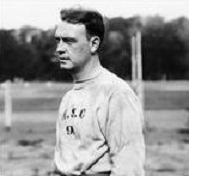
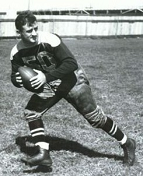
Another
team covered
above, Michigan State started great, tying #8 Michigan and beating #19
Colgate, but they finished poorly, losing to 5-5 Georgetown and tying
5-3-2 Detroit. Michigan State was an independent mid-major at this
time, sitting at about the power level of their main rival, Detroit
University.
Michigan
State had briefly risen to some prominence in football under head coach
John Macklin 1911-1915, beating Michigan twice and fielding an actual
MNC contender in 1913. But after Macklin
retired from coaching, the program sank back 1916-1928, going 43-60-6
over that time. Things started picking up again with the hire of Jim
Crowley (pictured above at left), Hall of Fame halfback for Notre
Dame's famed Four Horsemen backfield that had won the 1924 MNC. Crowley went 22-8-3 at MSU 1929-1933, and their 1932 team made the top 25 of that season's hypothetical AP poll.
Crowley moved on to greater fame as coach of Fordham, going 56-13-7
there 1934-1941. I credit him with an MNC for his 7-0-1 team in 1937. Overall he was 78-21-10, which places him on the list for best all-time FBS coaching win percentage.
The
star of this year's MSU team was halfback Bob Monnett (pictured above
at right). He would be named a nonconsensus All American in 1931, and
he went on to a notable career with the Green Bay Packers 1933-1938. He
is in the Green Bay Packers Hall of Fame.
Jim Crowley's
departure from Michigan State did not doom the program. The school
hired another Notre Dame grad, Hall of Fame coach Charlie Bachman, away
from Florida, and he went 70-34-10 at MSU 1933-1946, ushering them from
a mid-major program to a major independent. And he was followed up with
another Hall of Fame coach, Biggie Munn, who won an MNC at Michigan
State and ushered them into the Big 10.
Texas 8-1-1
Texas lost to
8-4 Rice and tied 8-1-1 Centenary, both unrated opponents, but they
beat 6-3-1 Baylor, 9-2-1 TCU, and 6-3-1 SMU. It's hard to say how good
the SWC was this season due to a paucity of relevant intersectional
games for the Southwest. SMU lost a surprisingly close game (20-14) to
#1 Notre Dame, but that was the only impressive result the SWC managed
in intersectional play. A loss. Still, Texas beat SMU 25-7, so they
outdid the #1 team in the country in that one regard. 8-1-1
Centenary had a nice straight record, but they took their loss to 2-7
Texas A&M, which in turn severely damages the team they tied, Texas.
Marquette 8-0-1
Marquette was tied by 5-3-2 Detroit, and did not beat a significant opponent.
McDaniel 9-0-1

McDaniel, then
known as Western Maryland, had gone 11-0 in 1929, and they went
unbeaten again this season, though obviously not untied. The team that
tied them was Albright, a lower-division type team, but a good one
(7-1-1). Western Maryland defeated 5-5 Georgetown 10-0 and 7-5 Maryland
7-0, very impressive for formerly lowly Western Maryland, but not quite top 25 worthy wins.
Western
Maryland was a minor team that happened to be helmed by a Hall of Fame
coach, Dick Harlow (pictured). Harlow had played for Penn State's
unbeaten 1911 MNC contender, and he went
20-8 as PSU's coach 1915-1917. He was 24-9-3 at Colgate 1922-1925, and
then he went 60-13-7 at Western Maryland 1926-1934, highlighted of
course by the 11-0 finish in 1929 and 9-0-1 this season. Harlow then
went 45-39-7 at Harvard 1935-1942 and 1945-1947, Harvard's first
non-alumnus head coach. Overall he was 149-69-17 for his career.
1930
Top 25
1) Notre Dame 10-0
2) Alabama 10-0
3) Northwestern 7-1
4) Southern Cal 8-2
5) Washington State 9-1
6) Tulane 8-1
7) Tennessee 9-1
8) Michigan 8-0-1
9) Stanford 9-1-1
10) St. Mary's (California) 8-1
11) Fordham 8-1
12) Army 9-1-1
13) Dartmouth 7-1-1
14) Ohio State 5-2-1
15) Wisconsin 6-2-1
16) Purdue 6-2
17) Georgia 7-2-1
18) Vanderbilt 8-2
19) Colgate 9-1
20) Utah 8-0
21) Yale 5-2-2
22) Oregon State 7-3
23) New York 7-3
24) Pittsburgh 6-2-1
25) Carnegie 6-3
Others
Receiving Votes:
Oregon 7-2
Michigan State 5-1-2
Minnesota 3-4-1
Texas 8-1-1
Marquette 8-0-1
McDaniel 9-0-1











